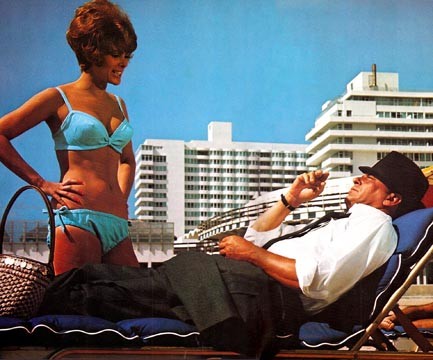| Intl. Notebook | Jul 3 2017 |

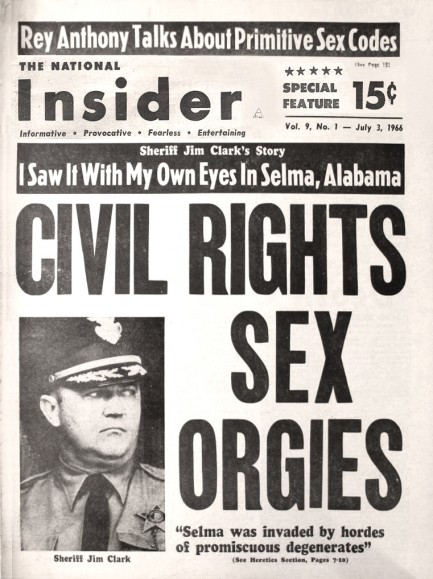
Above we have an issue of The National Insider that hit newsstands today in 1966, and as you can see the cover is given over to Sheriff Jim Clark, who tells the story of how he saw civil rights activists involved in an orgy in Selma, Alabama. Clark actually writes the article himself, and it's mostly a defense against unflattering portrayals of him in the national press. He claims the accounts are part of “one of the most effective propaganda campaigns since Josef Goebbels sold Adolf Hitler to 70 million Germans—and destroyed a nation in the process.” It's always best to drop Hitler into the narrative early, Godwin be damned. Clark goes on: “The civil rights organizations and their hired agitators who descended on Selma knew that the sheriff must enforce the law and maintain order. They knew, and I knew, that I was playing into their hands. I was the heavy. They were the martyrs.”
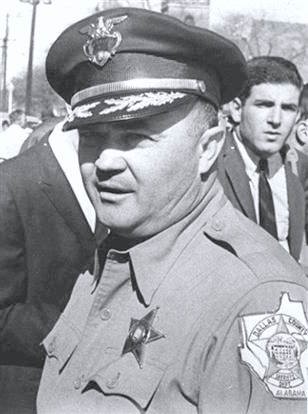 But what of the orgies? Here's Clark: “Dozens of Selma and Dallas County people swore to seeing sex acts between whites and Negroes. White teenaged girls making love in public with Negro men. White men dressed as priests making love with Negro girls. Make no mistake about it—sex and civil rights go together.” Of course this is always tactic number two. After refusing to accept the purpose behind civil protest, you then disparage the people. The fact that Clark went in a sexual direction shows what was really on his mind. “Sex and civil rights go together.” Which is to say, if blacks achieve the rights they seek, we can kiss our white girlfriends and daughters goodbye. It's almost comedy material, except it's hard to laugh knowing so many people were swayed by this argument. Sex is no longer overtly used as a propaganda weapon, but the smearing of rights protestors continues.
But what of the orgies? Here's Clark: “Dozens of Selma and Dallas County people swore to seeing sex acts between whites and Negroes. White teenaged girls making love in public with Negro men. White men dressed as priests making love with Negro girls. Make no mistake about it—sex and civil rights go together.” Of course this is always tactic number two. After refusing to accept the purpose behind civil protest, you then disparage the people. The fact that Clark went in a sexual direction shows what was really on his mind. “Sex and civil rights go together.” Which is to say, if blacks achieve the rights they seek, we can kiss our white girlfriends and daughters goodbye. It's almost comedy material, except it's hard to laugh knowing so many people were swayed by this argument. Sex is no longer overtly used as a propaganda weapon, but the smearing of rights protestors continues.Taking a step back and looking at it from the reality based world, we cannot think of any instances where civil rights protestors risked their safety and freedom fighting oppression that was a figment of their imaginations. In every case the protestors were correct, from southern Alabama to South Africa. Sometimes it's ethnic majorities that are oppressed, but never the economically dominant. Sometimes the economically oppressed and economically dominant are the same ethnicity, leading to scenes such as those during the Great Depression when white police violently broke up the protests of the white unemployed. But in order to believe that rights protestors would risk their already tenuous status over a non-issue, one already has to have a low opinion of them. The upshot of Clark's article is that the Selma marchers had no true grievances. We know today that's false. Similarly, there are people who would have us believe that today's civil rights protesters have no valid grievances. This again, is demonstrably false. We'll have more from The National Insider later.
| Politique Diabolique | Nov 3 2011 |

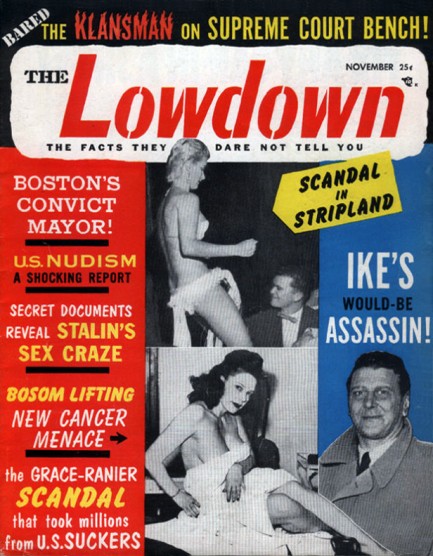
Lots of info in this Lowdown published in November 1956, but the prestigious banner position is reserved for a U.S. Supreme Court justice who editors claim was a member of the racist organization the Ku Klux Klan. The man in question is Hugo Black, a career Democrat who served on the high court until 1971, and indeed had been a member of the Klan in Alabama. You probably already know this, but for those few who don’t we’ll note here that the Democratic Party was the more conservative party in the U.S. with regard to racial issues until Democratic President John F. Kennedy endorsed, and his Democratic successor President Lyndon B. Johnson signed, the Civil Rights Act of 1964. This event led to the cementing of Democrats as the preferred party for black voters and the defection of millions of conservative white voters to the Republican Party, radically shifting the political spectrum of 1960s America (though only with regard to race, since both parties have drifted rightward on virtually all other issues since then).
Anyway, despite the KKK’s racist agenda, and the fact that Black’s racist bona fides were pristine (as a senator he once filibustered an anti-lynching bill), his Klan membership may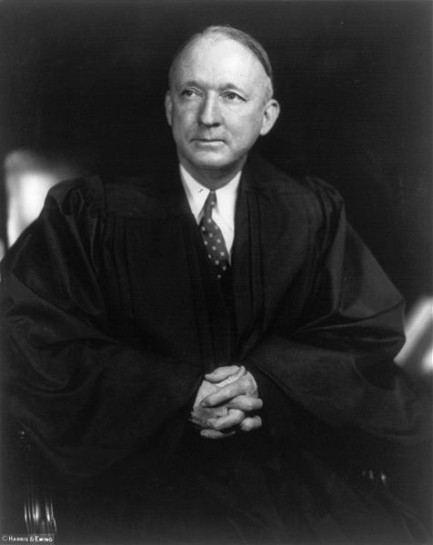 have been more strongly tied to the group’s anti-Catholic agenda. This in turn prompted him to become a leading defender of the U.S. Constitution’s First Amendment: i.e., the separation of church and state. In short, his fear and hatred of Catholics led him to do everything he could to keep religion out of politics. Or so certain biographers claim. Much more revealing, perhaps, are Black’s own words on the subject: “I would have joined any group if it helped get me votes.” Uttered near the end of his life, the phrase confirms once again—to us, at least—that a politician is a construct, not a person. Basically, you can never know what any of them really believe, because they’ll say anything to win office. Some of the most successful ones present a mask upon which the various segments of the public can project any face they wish. Maybe that’s why Hugo Black felt so comfortable under a hood.
have been more strongly tied to the group’s anti-Catholic agenda. This in turn prompted him to become a leading defender of the U.S. Constitution’s First Amendment: i.e., the separation of church and state. In short, his fear and hatred of Catholics led him to do everything he could to keep religion out of politics. Or so certain biographers claim. Much more revealing, perhaps, are Black’s own words on the subject: “I would have joined any group if it helped get me votes.” Uttered near the end of his life, the phrase confirms once again—to us, at least—that a politician is a construct, not a person. Basically, you can never know what any of them really believe, because they’ll say anything to win office. Some of the most successful ones present a mask upon which the various segments of the public can project any face they wish. Maybe that’s why Hugo Black felt so comfortable under a hood.
| The Naked City | Jun 29 2010 |

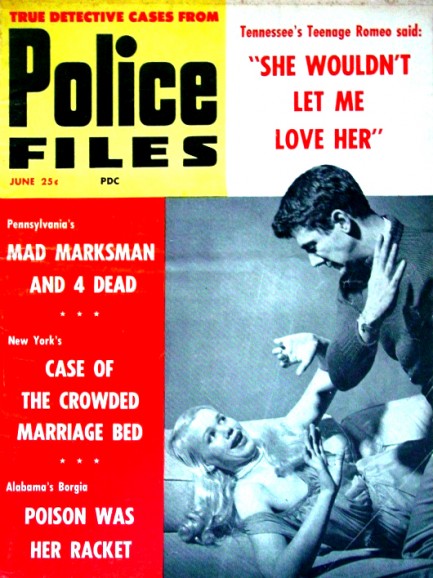
At trial Martin pleaded insanity. The jury wasn’t buying. Rhonda Belle Martin was executed in October 1957 in the Alabama electric chair. As to whether she was truly insane like the aunts in Arsenic and Old Lace, we’ll never know, but her third husband, an orderly at a Veteran’s hospital that housed hundreds of insane people, said she wasn’t. “Rhonda Belle, she ain’t no good-looking woman,” he said, “but she’s got personality and she’s smart.” In the end though, she wasn’t smart enough to elude detection. And as far as her magnetic personality went—when she was buried there were fewer people at her graveside than she had killed.
| Hollywoodland | Feb 18 2010 |

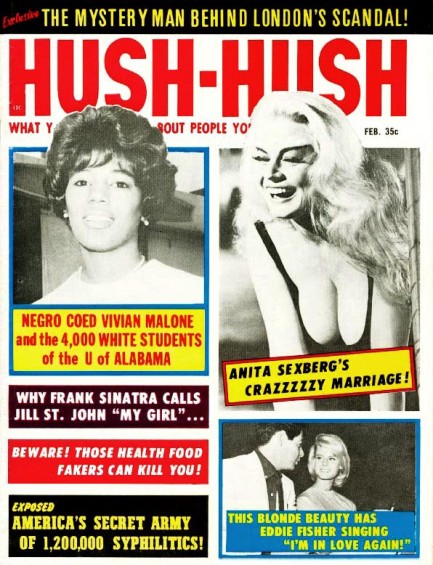
February 1964 Hush-Hush with Anita Ekberg and Vivian Malone. Malone was the woman who Alabama Governor George Wallace barred from entering the University of Alabama during the fall of 1963 after the U.S. Supreme Court ruled segregation unconstitutional. Wallace had state troopers at his back that morning, but when John F. Kennedy nationalized the Alabama National Guard later that day, they escorted Malone to school and the troopers were forced to step aside. Thanks to the court ruling, and Kennedy’s executive order, Malone earned a degree and worked in the U.S. State Department for thirty-one years.
Interestingly, her brother-in-law is the current U.S. Attorney General, Eric Holder. The cover blurb on Malone reads vaguely sexual, but of course the story has nothing to do with that. The Ekberg story is similarly smoke sans fire. You also get a feature on Frank Sinatra and Jill St. John. The two worked together in Come Blow Your Horn in 1963 and Tony Rome in 1967, but most sources say their brief involvement didn’t commence until 1971. However St. John was part of Sinatra’s “in-crowd” for years, and to be seen palling around with Frank was to be accused of waking up in his bed.
Every actress in Hollywood knew that, and few seemed terribly concerned. Finally, after making readers think about sex for most of the issue, Hush-Hush makes them afraid to do it themselves with a story on America’s syphilis epidemic. The mid-century tabs were very much like slasher movies in that way—in the end, sex must always be punished. We found a nice shot on Ebay of Sinatra and St. John together on the set of Tony Rome, and we've posted it below. Our next trick will be to try and find a tabloid that doesn't have Sinatra inside. We think we have our work cut out for us.